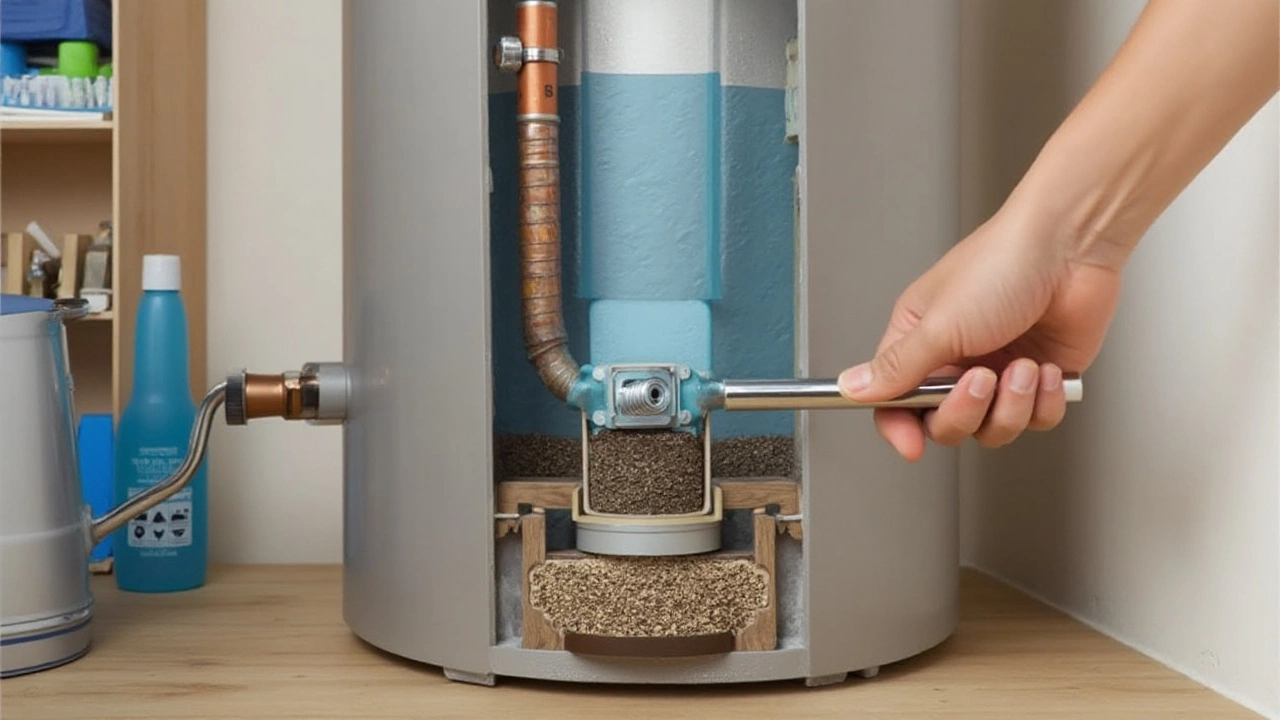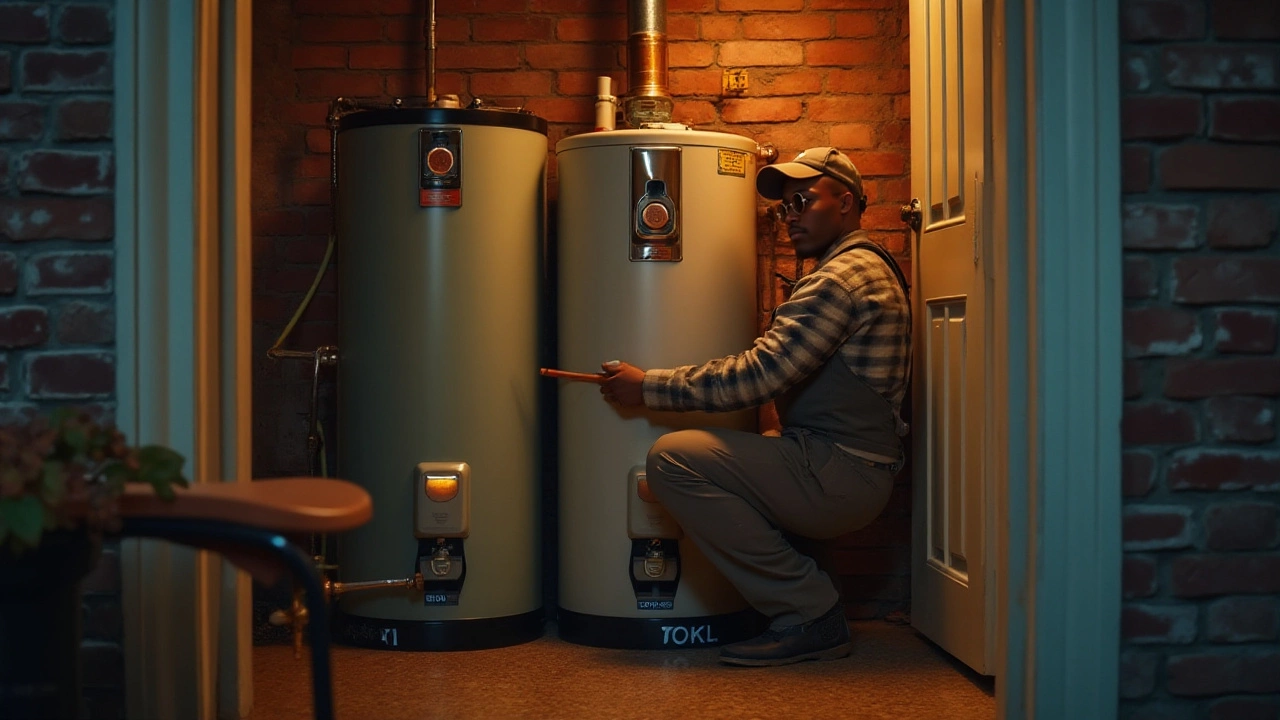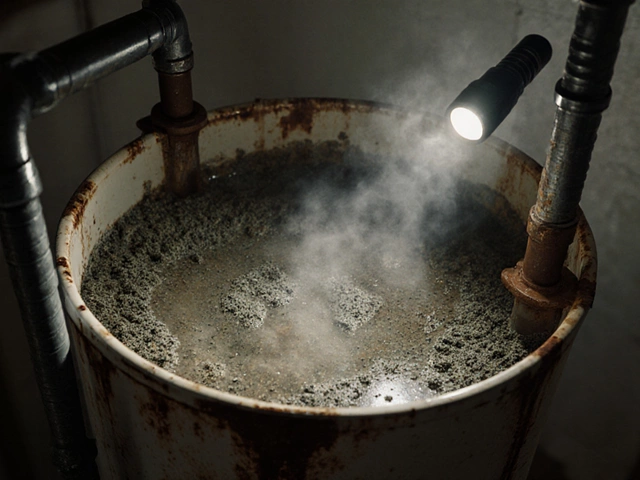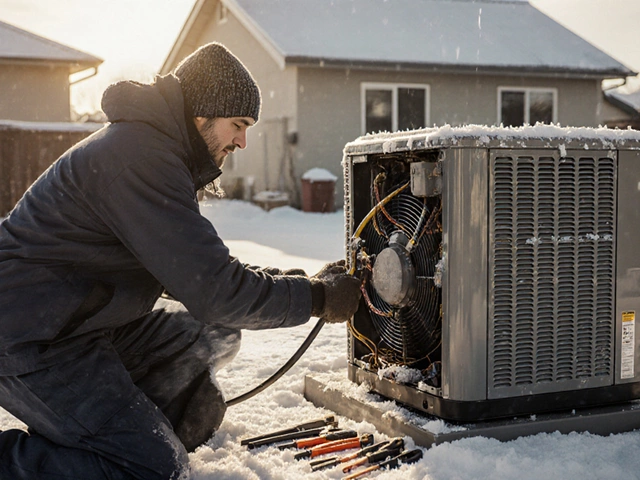Water heaters are an essential part of any home, but when they fail, it can be both inconvenient and costly. Recognizing the tell-tale signs of failure and knowing the common causes can make a significant difference in addressing these issues effectively. From sediment buildup to corroded anode rods, each problem comes with its own set of symptoms and solutions.
Understanding how these components work and fail can help homeowners troubleshoot potential issues before they escalate. Simple maintenance tips can also extend the life of the water heater, ensuring that hot showers are never far away. This article dives into these common issues and provides practical advice for keeping your water heating system in top shape.
- Common Causes of Water Heater Failure
- How Sediment Buildup Affects Performance
- The Role of a Malfunctioning Thermostat
- Anode Rods and Their Impact on Corrosion
- Signs Your Water Heater Needs Immediate Repair
- Preventative Maintenance Tips for Longevity
Common Causes of Water Heater Failure
Water heaters silently work behind the scenes, providing us with the comfort of hot showers and warm baths. Yet, for many homeowners, the little box tucked away in a corner comes with its share of unforeseen headaches. One of the most prevalent issues in this arena is a malfunctioning water heater, which often leaves us scratching our heads. Now, when we dive into the reasons behind such failures, some recurring culprits consistently surface, starting with the dreaded buildup of sediment. Over time, minerals from hard water inevitably settle at the bottom of the tank. As this layer thickens, not only does it reduce the efficiency of the heater, but it also causes it to work harder, leading to increased wear and tear. It's a bit like trying to boil an egg in a pot full of marbles. The excess sediment acts as an insulating layer, which prevents the burner from efficiently heating the water.
One can't talk about common water heater issues without mentioning thermostats. These vital components are responsible for regulating the temperature, ensuring that the water remains adequately heated. A malfunction in the thermostat can lead to inconsistent water temperatures or, worse, no hot water at all. This is akin to having a car with a faulty speedometer; it's impossible to judge how fast or safe the journey will be. It's noteworthy that regular inspections of the thermostat can prevent these unpleasant surprises. Speaking of surprises, a clanking sound from the heater could be a warning signal you shouldn't ignore. Such noises often precede bigger problems, like leaks or major system failures.
But let's not forget the unsung hero of the water heater: the anode rod. It's a sacrificial element designed to combat rust inside the tank. When the rod becomes entirely corroded, tank corrosion isn't far behind. Simply put, without a functional anode rod, the heater is living on borrowed time. Imagine an unguarded fortress slowly succumbing to an attacking army. Regularly checking and replacing the anode rod can be the barrier between the heater's longevity and a potential failure. This oversight, combined with improper pressure settings and neglecting to flush the system annually, often lead to water heater failure.
Lastly, water heaters operating on electricity are not immune to these issues. Burnt-out heating elements in electric heaters are another frequent troublemaker. Much like a light bulb that has reached its old age, they simply stop working and need replacement. These elements can often be replaced without requiring a complete overhaul, making it a comparatively simple fix for those facing this specific issue. In striving to extend the life of a water heater, understanding these common problems is the key. Armed with this knowledge, homeowners can act proactively, making informed decisions that save both time and money.
How Sediment Buildup Affects Performance
Sediment buildup is one of the sneaky culprits behind water heater failure that often goes unnoticed until problems arise. It occurs when minerals, primarily calcium and magnesium, settle at the bottom of the tank over time. This sediment forms a layer that insulates the water from the heating element, significantly reducing efficiency. This not only wastes energy but also leads to longer heating times. When a water heater has to work harder, it uses more electricity or gas, which can slowly drive up utility bills without homeowners even realizing it.
Another critical aspect of sediment buildup is the threat it poses to the internal components of the heater. The presence of these mineral deposits can cause the tank to overheat and prematurely wear out components. In some cases, the thermostat will register a false reading because of the insulating sediment layer, misleading the system into overworking. Over time, the constant heat on the bottom can damage the tank, leading to potential leaks. As odd as it might sound, the popping or rumbling noises some might hear from their heater are a direct sign of this sediment buildup. According to a study by the Water Quality Association, regular flushing of the tank could reduce the occurrence of these problems by up to 30%.
"Ignoring sediment buildup is akin to ignoring rust on a car. The results might not be immediate, but the accumulation leads to significant issues down the line," says Dr. Helen Waters, a senior researcher in home appliance efficiency.
To address this, homeowners must take proactive measures. Flushing the water heater annually can prevent sediment from taking hold. This involves attaching a garden hose to the drain valve and allowing the built-up sediment to flow out with the expelled water. Some heaters come with self-cleaning features that help reduce sediment accumulation, but they are not foolproof. Always follow the manufacturer's guidelines for maintenance, and consider installing a water softener if hard water is a persistent issue in the area. This device can reduce the mineral content, lowering the likelihood of sediment buildup.
Finally, investing in regular inspections by a qualified technician can catch and resolve sediment issues before they escalate. They can check the condition of the anode rod, which can also help combat sediment. These rods attract minerals, preventing them from settling at the bottom. In essence, understanding and managing sediment buildup is an indispensable step in ensuring the long-term efficiency and durability of your water heater.

The Role of a Malfunctioning Thermostat
The thermostat in a water heating system acts as the brain of the operation. It regulates the temperature, ensuring that water is heated to a desired level. However, when it malfunctions, not only can it lead to water being too hot or too cold, but it can also strain the entire system, leading to inefficiencies and costly repairs. An often overlooked aspect, the thermostat is pivotal in maintaining the balance of performance in any home water heating system.
When facing water heater problems, a malfunctioning thermostat is frequently the culprit. One of the signs that the thermostat may be failing is inconsistent water temperature, which can lead to discomfort and irritation. One moment, the water might be lukewarm, and the next, it could scald you. Such inconsistency is not just unpleasant; it is dangerous, especially in homes with children or elderly residents. It's crucial to address this issue swiftly to prevent hazards.
Among the technical aspects, thermostats can stop working due to electrical faults, aging wiring, or simple wear and tear. It's fascinating how something so small can cause such substantial issues. A common situation is the buildup of dirt or grime affecting the sensor's ability to read the actual temperature accurately. When the thermostat sensor is coated with sediment, it sends incorrect readings, which results in water temperatures that are outside the desired range, either too hot or insufficiently warm.
Often, a simple reset can suffice to remedy some minor thermostat issues. However, if the problem persists, it might be time to consider a replacement. Modern water heater models incorporate more advanced thermostatic devices with self-learning capabilities that adapt to usage patterns, resulting in improved efficiency. Investing in such technology can prevent the recurrence of thermostat-related issues in the future.
"The thermostat is the heart of the water heater. Like how an efficient heart ensures good health, a well-functioning thermostat guarantees consistent hot water supply and energy efficiency," says Elenor Rogers, an expert in domestic appliances.
Testing whether a thermostat is working correctly involves using a multimeter to check for continuity. If the test fails, replacing the thermostat is inevitable. It's a task that some homeowners may undertake themselves, but hiring a professional guarantees safety and correctness. With electricity being involved, it's sensible to err on the side of caution.
In terms of maintenance, ensuring that the thermostat and its surrounding components remain clean and dry is critical. Regular inspection and cleaning can forestall many of the foreseeable issues. The placement of the thermostat is also critical; it should be positioned in an area that allows easy access for any necessary repairs or adjustments. This small detail can make a significant difference in maintenance routines and lifespan of the water heating system.
Ultimately, for every home, understanding the vital role that the thermostat plays can lead to significant savings both in terms of economic and energy efficiency. Neglecting the thermostat can lead to more severe problems down the road, a headache that no homeowner wishes to experience. By being proactive and informed about the functionality and potential issues associated with the water heater thermostat, one can maintain an effective and reliable hot water supply.
Anode Rods and Their Impact on Corrosion
An often overlooked yet vital part of the water heater system is the anode rod. It plays a significant role in extending the life of your appliance by combating corrosion. Made from materials like magnesium, aluminum, or zinc, the anode rod is designed to corrode so that your water heater tank does not. This process is known as a "sacrificial" method. It's crucial to understand how this small part can make a huge impact on the overall functioning of the water heater.
When the water interacts with the metal in the tank, electricity flows, resulting in corrosion. The anode rod prevents this by sacrificing itself. Over time, the rod will corrode and disappear, which means it's doing its job. If the rod is consumed entirely, corrosion will turn its attention to the metal in the tank, potentially leading to leaks. Statistics show that neglecting anode rod replacement is one of the top contributors to premature tank failure. By regularly checking and replacing the anode rod, homeowners can avoid expensive repairs associated with tank corrosion.
Maintaining the anode rod is simple yet often neglected. Most experts recommend checking it every three years, although the frequency can vary depending on water quality and usage. Signs that the anode rod might need attention include water discoloration or a sulfur-like smell. If you're comfortable with DIY home maintenance, changing the rod can be a straightforward project. However, for those unsure, consulting a professional can ensure the task is done efficiently.
Renowned home maintenance expert Bob Vila once explained, "The anode rod is such a crucial element in prolonging the life of your water heater. Ignoring it is like ignoring the check engine light on your car."
The anode rod is often sheathed in mystery, appearing to be an insignificant part but holds the key to the water heater's longevity.His words underscore its importance, advocating for its regular inspection and timely replacement.
Different types of anode rods serve specific conditions. While zinc and aluminum rods are suited for harder water, magnesium rods are more effective for homes with soft water. To decide what's best for your water heater, consult with your local supplier or a plumbing expert. Is magnesium better for your home, or should you opt for aluminum? Making the right choice could add years to your water heater’s life cycle, preserving water heater efficiency and saving you costs.
How to Inspect and Replace the Anode Rod
A step-by-step guide can simplify the process of checking and replacing your anode rod. First, turn off the power to the water heater, then close the cold water supply valve. Release a few gallons of water from the tank for safety, and find the anode rod port at the top of the water heater. Use a wrench to unscrew the old anode rod and check its condition. If more than six inches of steel have been exposed, it's time for a replacement. Simply insert the new rod into the tank and tighten it. Restore the power and reopen the cold water supply.
Signs Your Water Heater Needs Immediate Repair
Recognizing when your water heater is in distress is crucial to preventing further damage. Imagine starting your morning with a shock — your usual stream of steaming water has turned into a freezing deluge. Such moments are a clear indicator that your water heater might need attention, and it’s important to be astute to other signs.
Perhaps you've noticed a shift in water temperature. A water heater that can't provide consistent hot water might have a defective thermostat. This could lead to unexpectedly cool showers or a cycle of scalding and cold water. Beyond discomfort, inconsistent heating often hints at problems that, if overlooked, can escalate to full system failure.
Noisy operations are another red flag. If your water heater starts to sound like a malfunctioning mechanical orchestra, with pops, bangs, or rumbling, it’s likely due to sediment buildup. As these minerals accumulate and harden at the bottom of your tank, they can cause your heater to work harder and more inefficiently, leading to those familiar clanks. Sometimes, you'll also notice rusty or cloudy water, signalling corrosion inside the tank, often due to a failing anode rod meant to prevent rust.
Leaking water heaters pose another immediate repair issue. Even a small leak can lead to bigger problems like water damage in your home. As the heater ages, components like valves and tank may weaken and begin to leak. Look for puddles around your unit or drips from the heater, which could indicate a serious internal failure. Swift repair action not only saves water but also prevents costly structural repairs.
Frequently tripped circuit breakers can be less obvious signs, especially if it happens every time the water heater is running. When electrical components, like the thermostat or heating elements, wear out, they can cause excess power draw, leading to a breaker trip. While it might seem a trivial electrical issue, constant interruption in power is often an indicator of a malfunctioning component requiring immediate attention.
Moreover, pay attention if the water heater is over ten years old and showing inefficiencies. Statistics reveal that water heaters typically last about 8 to 12 years. If your unit is past this expected lifespan, consider replacing or getting a professional assessment, as older heaters have a higher propensity for issues.
"Regular maintenance and timely repairs can extend the lifespan of a water heater by several years," suggests an expert from a reputed plumbing service.
Ultimately, being mindful of these indicators can prevent minor issues from snowballing into major repairs, safeguarding the warmth of your home’s hot water supply.
Preventative Maintenance Tips for Longevity
Ensuring the longevity of your water heater is not just about addressing issues as they arise but involves regular maintenance to stave off problems before they become significant. Many homeowners underestimate the value of routine maintenance until they find themselves shivering under an icy shower. Taking a few strategic steps can add years to your water heater's lifespan while maintaining its efficiency.
One of the most straightforward yet effective maintenance tasks is flushing your water heater tank regularly. Over time, sediment buildup forms at the bottom of the tank, which can lead to decreased efficiency and potentially damaging the inner lining. By draining the tank at least once a year, you clear out these deposits, allowing your heater to operate at its full capability. It’s an uncomplicated process requiring only a garden hose and a few minutes of your time. Draining involves attaching a hose to the tank's drain valve and letting the sediment-laden water flow out until it runs clear.
Another fundamental maintenance task involves checking the anode rod. This is a vital component that prevents corrosion within the tank by attracting minerals and elements that would otherwise corrode the lining. With time, the rod itself corrodes, so inspecting it annually to determine its condition is advisable. Replace the rod when it has been reduced to less than half an inch in thickness, or about every five years, to maintain its protective benefits. Investing in a new anode rod is far cheaper than replacing the entire water heater.
Temperature adjustment plays a crucial role in maintaining your water heater. While 60 degrees Celsius is often the recommended setting for ensuring bacteria like Legionella are kept at bay, higher settings can contribute to scalding and accelerate wear on your heater. Adjust the thermostat down to a comfortable yet efficient temperature to save on energy costs and reduce stress on the heating elements. This simple adjustment can prevent overheating, ensure optimal performance, and reduce energy bills significantly.
Safety: Pressure Release Valve Check
Don’t overlook safety elements like the pressure relief valve, which is crucial for preventing tank explosions. This valve releases pressure if the tank becomes too hot or the pressure builds up beyond safe levels. Testing this valve should be part of your annual maintenance checklist. To test, lift the valve's lever partway, letting it snap back. If the valve is functioning correctly, you’ll hear a gurgling sound as water escapes through the discharge pipe. If not, replacing this component is critical to ensure your system’s safety.
Finally, wrapping the tank with an insulating blanket can improve heat retention, especially in older models. These blankets are typically made of fiberglass, foil, or foam, and they prevent energy loss, a crucial step in homes experiencing extreme seasonal climates. Consider insulating hot water pipes as well, ensuring they maintain higher temperatures as water travels through the house, offering efficiency gains.
"Routine maintenance can extend the life of a water heater by several years" — John Smith, renowned plumber and author of 'Home Water Systems Made Simple'.
An ounce of prevention is worth a pound of cure. Implementing these preventative maintenance tips is not just about saving money; it’s about ensuring comfort, safety, and efficiency in your home. Water heaters are essential appliances that deserve attention and care to function at their best.




